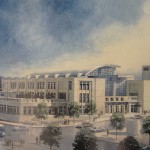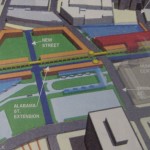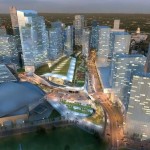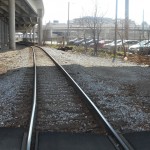The MMPT’s Failure (so far)
The most straightforward explanation for the failure of a new Terminal to rise likely revolves around politics and the vagaries of private finance. But underlying and structuring these local politics and the decisions of capital are two conceptual issues: Exactly what role does transportation play in a city’s life (this city’s life) and precisely what kind of a city is Atlanta?
Atlanta was born from rails and grew by rails, but then the metropolitan area metastasized via highways across more than 8,000 square miles of Georgia’s piedmont. Like most cities in the U.S., transportation patterns explain a great deal about Atlanta’s footprint and the rhythm of its growth. The proliferation of cars led directly to Terminal Station’s demise and to the proliferation of suburbs and new agglomerations competing for city center status. Those nodes emerged through the tightly linked give-and-take between public funding (building I-285, for instance) and private finance (building Perimeter Mall, for example). In the case of the MMPT, we can reasonably deduce that there has been too little give on the part of the government, meaning too little predicted take for developers.
No development, no MMPT:
During the initial bout of planning for the MMPT, the consulting firm A. T. Kearney’s 1995 report (described in the 1991-1995 section) had quite clearly described the limitations of the terminal as it was then conceived. The company argued that the project might be hamstrung by its limited development options. The Atlanta travel market lagged behind bigger cities (the report cited New York, Boston, and Chicago) and a terminal in this city would need to include business and private investment.
After additional years of work on the MMPT during its second phase of planning (1999-2003), a document was prepared soliciting bids for full-scale site surveys, design criteria, and feasibility work such as traffic studies. The initial section of this August 2002 document was a project description. This included six bullet points, the last of which was a terse phrase: “overbuild opportunities for private, mixed-use development.”[1]
The inclusion of development as an apparent afterthought rubbed readers the wrong way in the Mayor’s office and at the Georgia Regional Transportation Authority (GRTA). Michael Dobbins, an advisor to Atlanta Mayor Shirley Franklin, had written to GDOT engineers a month earlier, complaining that the predecessor document to this call for bids failed to fully capture the project’s character as a development opportunity.[2] In response to the call, Dobbins was more explicit. He arranged what he called the “‘big picture’ concerns” into his own bullets, the first of which what pointed: “clearly defining the project as a high quality, high density, mixed use development project, for which the transportation programs form the foundation and first phase of the work.”[3] That is, from the Mayor’s perspective, the MMPT was a development project first. The transportation angle was simply the “first phase.”
Dobbins may have been irritated that the previous two years of work hadn’t reflected his earlier hopes. He had written a much sunnier memo to the executive director of the GRTA in 2000, confidently stating that the MMPT planning would explore “the promise of joint or mixed-use development on the site.”[4] When he sent his sharp 2002 memo, two GRTA board members aired similar concerns. They sustained that the project must carefully include mixed-use development. They also argued that it should provide “linkage of the downtown area.”[5]
The MMPT’s current boosters put development front and center. GDOT’s 2015 State Rail Plan, now little more than a month old, frames the MMPT as transit-oriented development (TOD), a concept that has been central to planning since the early 1990s.[6] “An improved rail passenger route is but one part of a complete transportation offering,” the plan reads. “Other key factors are transit, taxi connections, auto access, pedestrian and bicycle access, and transit-oriented development (TOD).” “By using the rail station as a development tool,” the plan goes on, “TOD builds rail ridership and builds communities.”[7]
Of course, “TOD” won’t build anything. TOD is a concept, not an institution, agency, or corporation. Advocates of TOD make attractive claims about community building, as the GDOT rail plan authors do, but a project like the MMPT depends on extensive public-private cooperation. And private developers need return on investment, not communities. The two optimally go hand in hand, but not all of the aspects of a strong community will necessarily be nurtured under these conditions. The Mayor’s office and the GRTA may have had an accurate assessment of the 2002 project’s limitations: too much transit, too little development. It’s not an uplifting view if community is one’s primary concern, but it seems accurate for Atlanta.
Why build a hub terminal for a city with no heart?
When the railroads built Terminal Station in 1905, few would have argued that the station was misplaced. The Circle Wye sat at the heart of the city. By the 1990s, Atlanta had lost its heart. Downtown’s energy edged northward with Peachtree Center. Midtown captured developers’ attention farther north on Peachtree. Buckhead raced to build one shiny building after another. The 1993 extension of Georgia Highway 400 connected Buckhead to Perimeter Center, feeding yet another site competing for primacy.
One long-term Atlanta transportation official called attention to this pattern in comments to the PMT in 2001. Paul Kennedy had worked as a MARTA planner for 17 years before moving to transportation consulting. While at MARTA, he had worked on the earlier MMPT design planning, so when he sent comments to the PMT he wrote with an insider’s perspective. Kennedy opposed continued work toward an MMPT along the lines conceived in 1994 and renewed in 2000. “The concept must fit the existing city and therein is the problem,” Kennedy wrote, “Atlanta is a linear city.” Kennedy argued that Atlanta needs a Multi-Modal Passenger System, rather than a terminal. He recommended spreading the transportation services around the city, linking everything to appropriate MARTA stations. MARTA forms the “spine” of the city, which spreads out along its tracks, especially the red and gold lines running north and south.
Despite Kennedy’s objections, every entity with a stake in the city and region’s future planning continues to treat Atlanta’s morphology, and its current transportation infrastructure, as amenable to a central hub. The page on the 2011-2014 phase attests to that. The MMPT appears in the City of Atlanta’s Connect Atlanta Comprehensive Transportation Plan, Central Atlanta Progress’s Green Line project, the ARC’s Regional Transportation Plan, and its Concept 3 planning document.
The Green Line’s prescription for MMPT, park, road, and bridge construction, along with investments in new bus and rail systems serving the terminal, has a $6.2 billion price tag.[8] But planners foresee the MMPT generating 22.5 million additional transit trips by 2040, with enormous savings to travelers. The economic impact analysis predicts more than 5,000 additional Atlanta jobs by 2020 and nearly 27,000 by 2040. These numbers presume a great many more rail passengers than Atlanta currently sees. In 2008, Amtrak’s Brookwood Station saw an average of 277 travelers per day.[9]
The problem of too much transit and too little development derives in large part from Atlanta’s urban structure. If the Gulch really did still exist at the heart of the city, developers could be secure in predicting massive flows of passengers and commuters. But people travel in large numbers to a large number of nodes. And there simply aren’t enough inter-city rail travelers, as the Amtrak statistics demonstrate.
It would seem that a successful MMPT might have to wait for a transformation in transportation patterns. If plans for a regional rail network and expanding national rail ever come to fruition, perhaps then we will have a major terminal in Atlanta to replace Terminal Station.
—
[1] Draft scope of work for the MMPT Schematic Design Request for Proposal, distributed by Hal Wilson, Administrator of the Office of Intermodal Programs at GDOT on August 13, 2002. Held in RCB 60160, Multi-Modal/City of Atlanta Folder, Georgia Archives.
[2] “Attachment to July 30, 200 memo from Mike Dobbins to Paul Mullins and Hal Wilson,” in RCB 60160, Multi-Modal/City of Atlanta Folder, Georgia Archives.
[3] August 23, 2002 Letter from Michael Dobbins to Paul Mullins and Hal Wilson, RCB 60160, Multi-Modal/City of Atlanta Folder, Georgia Archives.
[4] Memo, Michael A. Dobbins to Catherine Ross, July 5, 2000, in RCB 60160, Georgia Archives. The GRTA’s executive director at the time was Catherine Ross, who now holds an endowed chair at Georgia Tech.
[5] MMPT comments by Mr. Steve Bruning and Ms. Sharon Gay, August 29, 2002, in RCB 60160, Multi-Modal/City of Atlanta Folder, Georgia Archives. Bruning, Gay, and Dobbins were all reacting to the document Hal Wilson had circulated.
[6] Ian Carlton, “Histories of Transit-Oriented Development: Perspectives on the Development of the TOD Concept,” Berkeley Institute of Urban and Regional Development, Working Paper 2009-02, 1. Carlton credits Peter Calthorpe with coining the term and popularizing it in his 1993 book The New American Metropolis.
[7] Georgia Department of Transportation, Georgia State Rail Plan, 2015, Draft, March 2015, 37-38.
[8] Economic Impact Analysis of the Downtown Green Line Vision Plan and Georgia Multi-Modal Passenger Terminal, 7.
[9] Jim Cox, Rails Across Dixie: A History of Passenger Trains in the American South (McFarland, 2010), 328.







